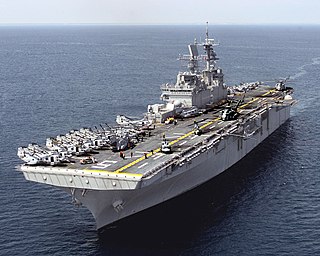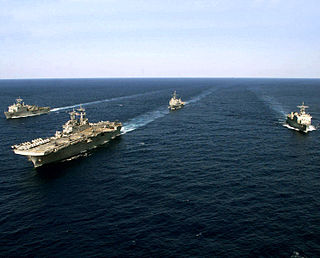
A Marine expeditionary unit is the smallest air-ground task force (MAGTF) in the United States Fleet Marine Force. Each MEU is an expeditionary rapid reaction force ready to any crisis, whether it be disaster aid or a combat mission. Marine amphibious unit (MAU) was the name used until the late 1980s.

USS Tarawa (LHA-1), the lead ship of her class, is an amphibious assault ship that served in the United States Navy from 1976 to 2009. She is the second ship to be named for the Battle of Tarawa, fought during World War II. Tarawa was decommissioned on 31 March 2009, at San Diego Naval Base.

The Tarawa class is a ship class of Landing Helicopter Assault (LHA) type amphibious assault ships operated by the United States Navy (USN). Five ships were built by Ingalls Shipbuilding between 1971 and 1980; another four ships were planned, but later canceled; instead they were joined by the Wasp-class amphibious assault ships.

The Wasp class is a class of landing helicopter dock (LHD) amphibious assault ships operated by the United States Navy. Based on the Tarawa class, with modifications to operate more advanced aircraft and landing craft, the Wasp class is capable of transporting almost the full strength of a United States Marine Corps Marine Expeditionary Unit (MEU), and landing them in hostile territory via landing craft or helicopters as well as providing air support via AV-8B Harrier II attack aircraft or F-35B Lightning II stealth strike-fighters. All Wasp-class ships were built by Ingalls Shipbuilding, at Pascagoula, Mississippi, with the lead ship, USS Wasp, commissioned on 29 July 1989. Eight Wasp-class ships were built, and as of April 2021, seven are in active service, as USS Bonhomme Richard was seriously damaged by fire on 12 July 2020, and subsequently decommissioned in April 2021.

USS Wasp (LHD-1) is a United States Navy multipurpose amphibious assault ship, and the lead ship of her class. She is the tenth USN vessel to bear the name since 1775, with the last two ships named Wasp being aircraft carriers. She was built by the Ingalls Shipbuilding division of Litton in Pascagoula, Mississippi. Wasp and her sister ships are the first specifically designed to accommodate new Landing Craft Air Cushion (LCAC) for fast troop movement over the beach, and Harrier II (AV-8B) Vertical/Short Take-Off and Landing (V/STOL) jets which provide close air support for the assault force. She can also accommodate the full range of Navy and Marine Corps helicopters, the tiltrotor MV-22 Osprey, the F-35B Lightning II multi-role fighter, conventional landing craft, and amphibious vehicles.

USS Essex (LHD-2) is a Wasp-class Landing Helicopter Dock (LHD) in service with the United States Navy. The amphibious assault ship was built at what is now Huntington Ingalls Industries in Pascagoula, Mississippi. She was launched 23 February 1991 and commissioned on 17 October 1992 while moored at Naval Air Station (NAS) North Island. She is the fifth ship named for Essex County, Massachusetts. Essex served as the command ship for Expeditionary Strike Group Seven until replaced by USS Bonhomme Richard on 23 April 2012.

USS Bataan (LHD-5) is a Wasp-class amphibious assault ship in the United States Navy. This ship is named after the Battle of Bataan, fought in the Philippines during World War II.

Landing helicopter assault (LHA) is the United States Navy's hull classification symbol for the general-purpose helicopter-carrying amphibious assault ships of the Tarawa and America classes.

An amphibious ready group (ARG) of the United States Navy consists of a naval element—a group of warships known as an Amphibious Task Force (ATF)—and a landing force (LF) of U.S. Marines, in total about 5,000 people. Together, these elements and supporting units are trained, organized, and equipped to perform amphibious operations.

Operation Unified Assistance was the American military's humanitarian response to the 2004 Indian Ocean earthquake and tsunami. On 28 December 2004, elements of the Combined Support Force were deployed to U-Tapao International Airport in Thailand. More than 12,600 Department of Defense personnel were involved in the relief effort.

USS Pearl Harbor is a Harpers Ferry-class dock landing ship of the United States Navy. She was named for Pearl Harbor, where World War II began for the United States.

The America class is a ship class of landing helicopter assault (LHA) type amphibious assault ships of the United States Navy (USN). The class is designed to put ashore a Marine Expeditionary Unit using helicopters and MV-22B Osprey V/STOL transport aircraft, supported by AV-8B Harrier II or F-35 Lightning II V/STOL aircraft and various attack helicopters. The first of these warships was commissioned by the U.S. Navy in 2014 to replace USS Peleliu of the Tarawa class; as many as eleven will be built. The design of the America class is based on that of USS Makin Island, the last ship of the Wasp class, but the "Flight 0" ships of the America class will not have well decks, and have smaller on-board hospitals to provide more space for aviation uses.

The 15th Marine Expeditionary Unit is one of seven such units currently in existence in the United States Marine Corps. The Marine Expeditionary Unit (MEU) is a Marine Air Ground Task Force (MAGTF) with a strength of about 2,200 personnel. The MEU consists of a command element, a reinforced infantry battalion, a composite helicopter squadron and a combat logistics battalion. The 15th MEU is currently based out of Marine Corps Base Camp Pendleton, California.

The 31st Marine Expeditionary Unit is one of seven Marine Expeditionary Units in existence in the United States Marine Corps. The Marine Expeditionary Unit is a Marine Air Ground Task Force with a strength of about 2,200 Marines and sailors. The 31st MEU consists of a company-sized command element, a battalion landing team (BLT),, a medium tiltrotor squadron (reinforced),, and a combat logistics battalion. The 31st MEU is based at Camp Hansen, Marine Corps Base Camp Smedley D. Butler, Okinawa, Japan. The 31st MEU is the only permanently forward-deployed MEU, and provides a flexible and lethal force ready to perform a wide range of military, humanitarian, and diplomatic operations as the premier crisis response force in the Indo-Pacific region.

The United States Marine Corps is organized within the Department of the Navy, which is led by the Secretary of the Navy (SECNAV). The most senior Marine commissioned officer is the Commandant of the Marine Corps, responsible for organizing, recruiting, training, and equipping the Marine Corps so that it is ready for operation under the command of the unified combatant commanders. The Marine Corps is organized into four principal subdivisions: Headquarters Marine Corps, the Operating Forces, the Supporting Establishment, and the Marine Forces Reserve.

Expeditionary Strike Group 3 is an expeditionary strike group (ESG) of the U.S. Navy. Expeditionary strike groups combine the capabilities of surface action groups, submarines, and maritime patrol aircraft with those of Amphibious Ready Groups for deployment and maintaining staff proficiencies to provide fleet commanders with a highly flexible, ready fly-away unit. It is capable of projecting expeditionary striking power in the maritime, littoral, and inland environs in support of U.S. national interests.

USS America (LHA-6), is an amphibious assault ship of the United States Navy and the lead ship of the America-class amphibious assault ship. The fourth U.S. warship to be named for the United States of America, she was delivered in spring of 2014, replacing Peleliu of the Tarawa class. Her mission is to act as the flagship of an expeditionary strike group or amphibious ready group, carrying part of a Marine expeditionary unit into battle and putting them ashore with helicopters and V-22 Osprey tilt-rotor aircraft, supported by F-35B Lightning II aircraft and helicopter gunships.

An amphibious assault ship is a type of amphibious warfare ship employed to land and support ground forces on enemy territory during an amphibious assault. The design evolved from aircraft carriers converted for use as helicopter carriers. Modern designs support amphibious landing craft, with most designs including a well deck. Coming full circle, some amphibious assault ships also support V/STOL fixed-wing aircraft, now having a secondary role as aircraft carriers.

Expeditionary Strike Group SEVEN/Task Force 76 is a United States Navy task force. It is part of the United States Seventh Fleet and the USN's only permanently forward-deployed expeditionary strike group. It is based at the White Beach Naval Facility at the end of the Katsuren Peninsula in Uruma City, Okinawa, Japan.



















